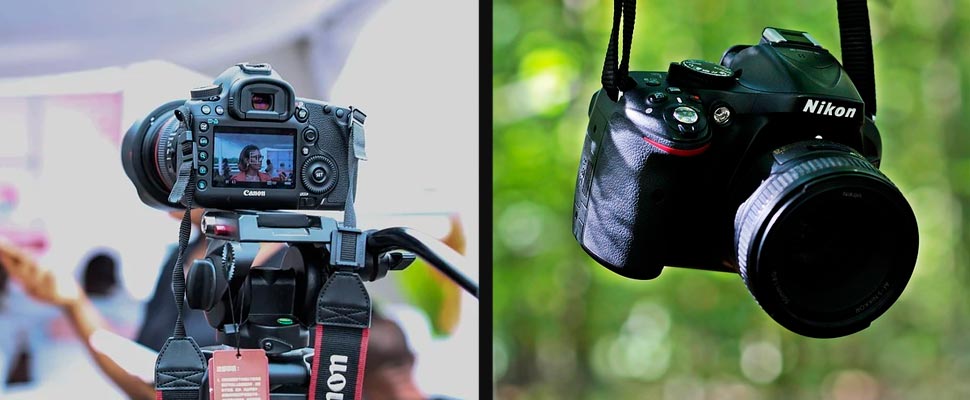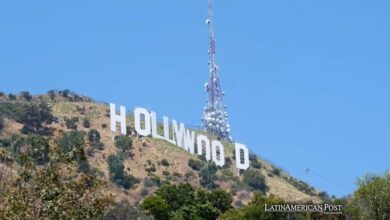Canon vs Nikon: the rivalry of the most popular cameras
When we talk about photography, we automatically associate it with these two brands
When we talk about photography, we automatically associate it with these two brands.

Canon and Nikon are the two big reference brands in photography. / Photos: Pixabay
LatinAmerican Post | Ariel Cipolla
Listen to this article
Leer en español: Canon vs Nikon: la rivalidad de las cámaras más populares
Day by day, we see that photographic technology is improving. Some of this happens in phones, which are increasingly incorporating quality sensors. An example occurs, according to the Xataka website, in the 0.7-micrometer ISOCELL sensors that Samsung presented, which can have up to 108 megapixels.
Despite the fact that cell phone technology is getting better in photographic terms, there is a reality that seems to continue with the passage of time. We are talking, of course, about professional cameras, with Canon and Nikon being the main references in this sector of the market, which is always active and constantly evolving.
For example, from The Output, they highlight that, recently, the Canon EOS C70 was presented, a camera designed for the cinema, but accessible to many people in terms of price. Knowing how both brands have evolved over time, we decided to review the rivalry between Nikon and Canon, leading companies in photography issues.
Canon vs Nikon
To begin to understand this dispute, we must understand how it began. We know that Nikon was born before Canon. In 1917, the president of Mitsubishi, Koyata Iwasaki, decided to create a company that was a pioneer in the manufacture of optical components, giving birth to the idea of the Japanese Nikon.
Canon, on the other hand, had to wait a little longer. As revealed by AXPE Consulting Photography, this specialized company, also Japanese, was created in 1937 by Goro Yoshida, who sought to promote research to create cameras that could be accessible to everyone, not only to a restricted sector of the population.
In the beginning, the two companies were not competing with each other. From Nikon, there was the idea that they could develop better optics, while Canon was betting on the manufacture of cameras. All this, at the same time, in a context where Japanese nationalism began to flourish, betting on the independence of European products.
This is why it should come as no surprise that, at first, both companies worked together to generate a product. According to Xataka, the Nikon One was created in 1946, an essential camera for the history of photography, which was sold for $ 406,000 at an auction held in 2016.
In other words, the first Canon camera was actually made by parts of Nikon, so they decided to use the latter company as a name. The move was clear: to satisfy the demand of the Japanese, who wanted to venture into the field of photography. Despite the great results, from Canon, they wanted to bet on individualization, without having to work with Nikon.
Also read: The problem of tax evasion in Latin America
All this comes hand in hand with what, according to the CSR Commitment website, is the essence of the brand: the Kyosei philosophy. From Canon's perspective, it is essential that they can live and work together to generate a common good, harmonizing the work team to become independent and even surpass the market leader Leica.
With the passing of time, it was observed that this last brand continued to be the market leader. Especially, the Leica M3, launched in 1954, is considered a "revolutionized rangefinder camera", incorporating a rangefinder in the viewfinder, a fast forward lever, and the automatic selection of frame lines in the viewfinder for different focal lengths, among others.
Despite various improvements from Canon and Nikon, the breaking point would be in 1991, at which point the digital revolution begins. The introduction of the Kodak DCS 100, which, according to Gizmos, was considered the first digital SLR camera in history, was actually a Nikon F3 connected to an external system with digital backup and 200 Mbyte storage.
However, by then there was still no democratization of DSLRs, that is, digital SLR cameras. In 2003, the launch of the Canon EOS 300D catapulted the company into offering the first affordable DSLR in history, priced at around $ 1,000. Of course, from Nikon, they would not stand idly by, so in 2004 the Nikon D70 was launched, a camera to compete with it.
A year later, in 2005, we saw that high definition appeared on digital television, which is why an improvement in this aspect was also needed. In 2005 the Canon EOS 5D appeared, the first full-frame DSLR that opened a new market niche. Its enormous quality, at the same time, opened the range of possibilities in the photography market.
However, contrary to what many people think, it was not until 2008 when the possibility of video was introduced in SLRs, with Canon and Nikon being pioneers in this area. We are talking about the Nikon D90, which allowed to capture HD video at 720 p and 24 images per second; while a year later, in 2009, Canon did its thing with the Canon EOS 5D Mark II, which, the specialized website for Cameras and Lenses describes as a "prodigy", since it introduced 1080p video recording. fps (that is, Full HD).
From there, everything was specialization for both companies, which fully established themselves in the market as undisputed leaders. Hence, for example, specialized media, such as The Photographer's Blog, wonder which is better or what advantage each one has. What is clear is that, thanks to innovation, they were able to rival and improve the market with cameras for everyone.




